Your Athletic Meal Plan Is Missing the Most Important Ingredient: Perfect Timing

Table of Contents
- Why Your Body Clock Controls Everything About Performance
- The Hidden Hormonal Dance That Makes or Breaks Your Gains
- How Your Cells Actually Repair (And When They Do It Best)
- Your Gut Bacteria Have Their Own Schedule Too
- Food as Genetic Programming: Beyond Basic Nutrition
- Training Your Body to Burn Any Fuel Source
- Feeding Your Brain for Mental Performance
- The Energy Field of Food (Yes, Really)
- Eating With the Seasons Like Our Ancestors Did
TL;DR
- Your body’s internal clock controls when you best process carbs, proteins, and fats – timing matters way more than you think
- Morning cortisol peaks make 6-10 AM the golden window for carbohydrate consumption
- Growth hormone surges during sleep, so casein protein 2-3 hours before bed can boost overnight muscle building by 22%
- Your gut bacteria operate on their own daily schedule – feed them at the right times for better absorption
- Certain foods literally turn performance genes on and off within 2-4 weeks
- You can train your metabolism to efficiently switch between glucose, fat, and ketones as fuel sources
- Brain nutrients consumed at specific times enhance focus, decision-making, and stress tolerance during competition
- Fresh, living foods carry electromagnetic energy that processed foods simply don’t have
- Your nutritional needs shift with the seasons – fighting this natural rhythm hurts performance
Why Your Body Clock Controls Everything About Performance
I used to be that athlete who’d crush a workout at 6 AM, then crash hard by 2 PM. I thought I just had weird energy patterns until I discovered my body was basically screaming at me about timing.
Turns out, your internal clock isn’t just about when you sleep – it’s running the entire show behind the scenes. Your body’s 24-hour rhythm controls hormone production, enzyme activity, nutrient absorption, and cellular repair. Understanding this timing can amplify your performance gains by 15-30% compared to just focusing on what to eat without considering when to eat it.
Most athletes obsess over hitting their macros but completely ignore the timing. I get it – I used to do the same thing. But when I learned that my body processes nutrients completely differently at 8 AM versus 8 PM, everything changed.
Research shows that male and female athletes have caloric needs exceeding 2,400-3,000 kcal and 2,200-2,700 kcal per day respectively, yet timing these calories correctly can make the difference between peak performance and energy crashes. “Eating for Peak Athletic Performance” – UW Health
Your hormone levels follow predictable schedules throughout the day. Cortisol peaks in the morning, growth hormone surges during deep sleep, and your ability to handle carbs fluctuates in ways that most nutrition plans completely ignore. When you align your eating with these natural patterns, everything just works better.
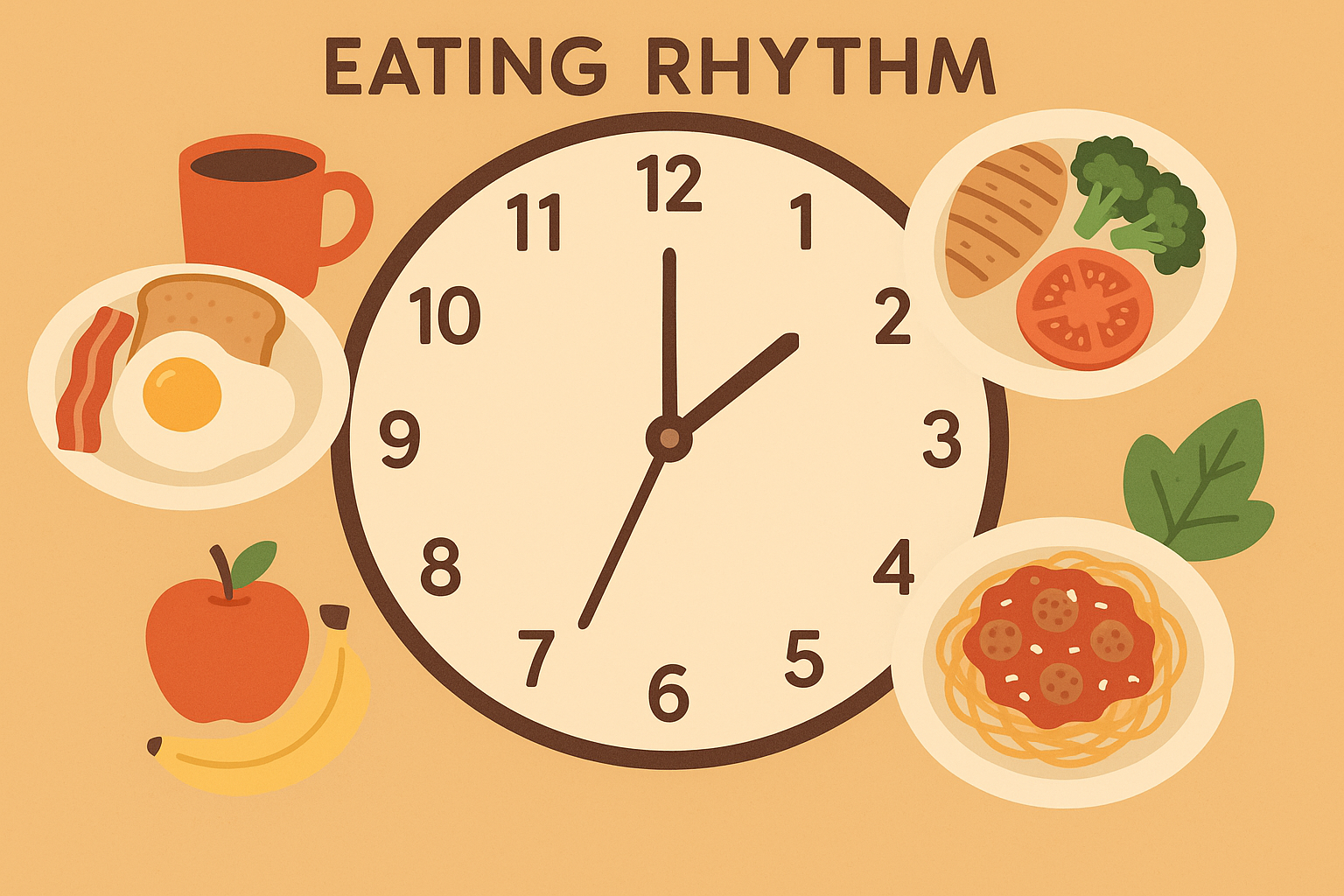
The Hidden Hormonal Dance That Makes or Breaks Your Gains
Your hormones follow predictable daily patterns that create perfect windows for different nutrients. Here’s where it gets interesting – that morning cortisol spike everyone complains about? It’s actually your carb-processing superpower.
When cortisol peaks between 6-10 AM, your body becomes incredibly efficient at metabolizing glucose and storing it as muscle fuel rather than fat. This completely changed how I structure my day.
I now consume 40-60% of my daily carbs during this morning window. The difference in energy stability throughout the day is remarkable – no more 3 PM crashes that used to make me want to face-plant into my desk.
When Cortisol Actually Helps Your Performance
That morning cortisol spike isn’t your enemy – it’s preparing your muscles to soak up glucose and convert it to stored energy like a sponge. I’ve started having my biggest carb meal right after my morning workout, usually around 8 AM. Oatmeal with berries, maybe some sweet potato – foods that would normally make me crash later in the day but now fuel me perfectly.
This approach aligns perfectly with proper oatmeal preparation techniques that maximize nutrient absorption.
| Time Window | Optimal Macronutrient | Hormonal State | Best Food Choices |
|---|---|---|---|
| 6-10 AM | 40-60% daily carbs | Peak cortisol | Oatmeal, berries, sweet potato |
| 10 AM-2 PM | Balanced macro ratio | Stable insulin | Lean protein, complex carbs, healthy fats |
| 2-6 PM | Moderate carbs, higher protein | Declining cortisol | Chicken, quinoa, vegetables |
| 6-10 PM | Low carbs, casein protein | Rising growth hormone | Greek yogurt, nuts, leafy greens |
The Nighttime Muscle-Building Window
Here’s something that completely changed my recovery game: your body does most of its muscle building while you sleep, not right after your workout. Growth hormone starts pumping about 90 minutes after you fall asleep.
Casein protein before bed isn’t just old-school bodybuilder wisdom – it’s strategic timing. I have about 30g of casein (usually in Greek yogurt form) around 9 PM when I go to bed at 11. My recovery improved noticeably within two weeks.
Growth hormone release begins 90 minutes after sleep onset, creating an optimal window for protein synthesis. Consuming 25-30g of casein protein 2-3 hours before bed can increase overnight muscle protein synthesis by up to 22%, maximizing recovery while you sleep.
Your Body’s Carb Tolerance Changes All Day
You know that 3 PM energy crash that makes you want to face-plant into your desk? That’s probably because you had pasta at 8 PM last night when your body was basically saying “please, no more carbs.”
Your ability to handle carbs isn’t the same at 8 AM versus 8 PM. Your body’s sensitivity to insulin naturally declines as the day progresses, which means that pasta dinner might not be doing you any favors.
I’ve restructured my entire eating schedule around this. Heavy carbs in the morning and post-workout, moderate amounts at lunch, and mostly protein and fats for dinner. The difference in how I feel and sleep is dramatic.
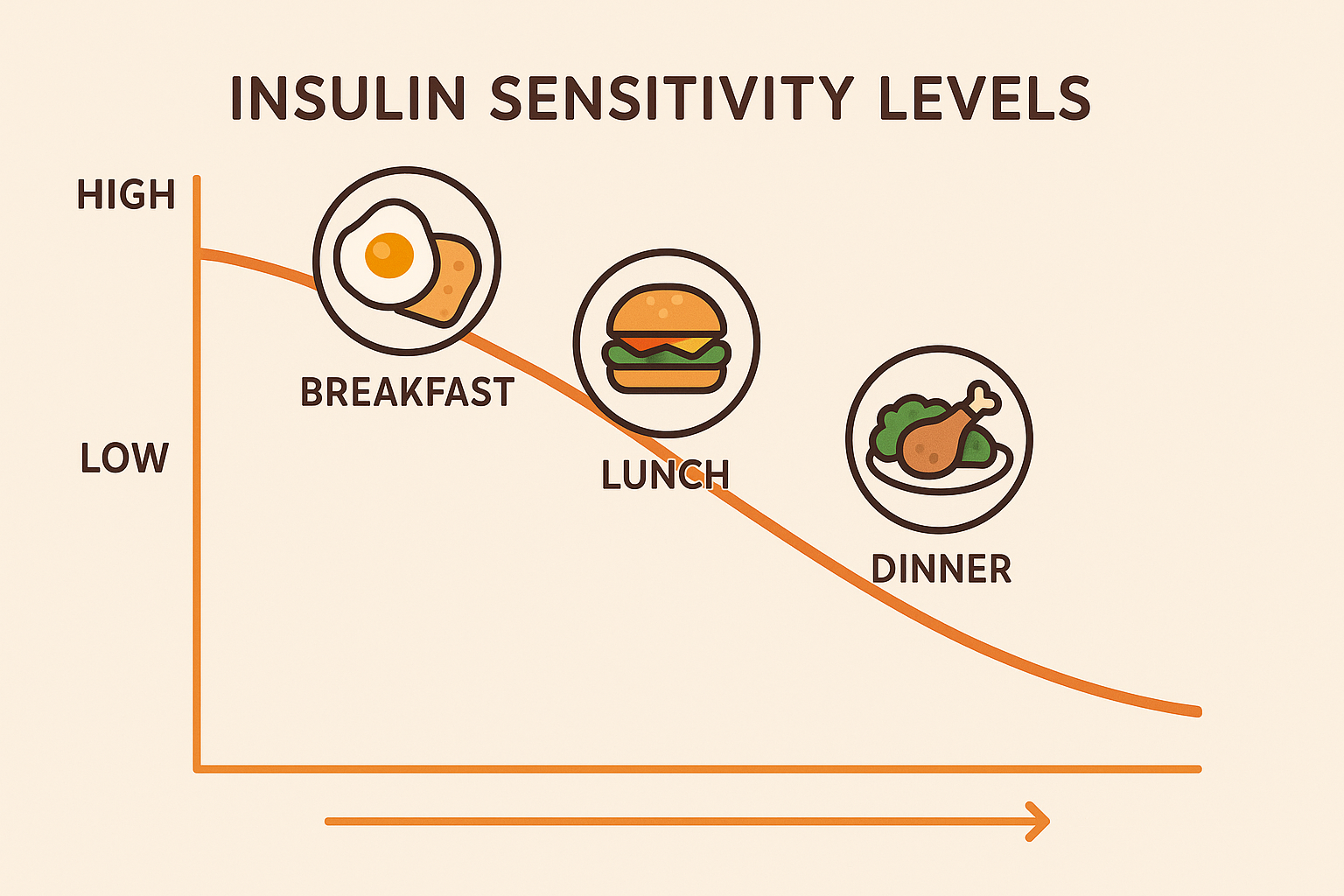
How Your Cells Actually Repair (And When They Do It Best)
Your cells don’t just randomly decide to repair themselves – they follow a strict schedule. Your body’s cleanup time (called autophagy) happens most efficiently during extended fasting periods, typically overnight.
This completely changed how I think about recovery nutrition. Instead of constantly feeding my body, I now give it strategic breaks to focus on repair work.
Cellular repair follows your body’s internal clock, with mitochondrial repair (fixing your cellular powerhouses) peaking during specific windows. This creates opportunities to enhance recovery through strategic nutrient timing rather than just focusing on post-workout supplementation.
When Your Cells Take Out the Trash
Think of autophagy as your cells’ housekeeping service, but it only kicks into high gear when you’re not constantly digesting food. I now do 14-16 hour fasts twice a week, usually Tuesday and Friday.
During these extended fasts, I’ll still train but only consume electrolytes and maybe some amino acids. The mental clarity and recovery benefits are worth the temporary hunger pangs. This approach complements the proper intermittent fasting protocols that support athletic performance.
Sarah, a competitive swimmer I know, implemented 16-hour fasts on her rest days. She consumed her last meal at 8 PM Tuesday, then didn’t eat until noon Wednesday, drinking only water and electrolytes during her morning swim practice. Within three weeks, she noticed significantly improved recovery times and better sleep quality.
Timing Your Cellular Powerhouse Upgrades
Your mitochondria – the powerhouses of your cells – get upgraded while you sleep. But you can support this process by timing certain nutrients correctly.
I take CoQ10, PQQ, and magnesium around 8 PM, about 3 hours before bed. Think of it as giving your body the raw materials it needs for overnight construction work.
New mitochondria formation occurs primarily during deep sleep phases. Strategic consumption of CoQ10, PQQ, and magnesium 3-4 hours before bed can amplify this natural process, supporting the creation of new cellular powerhouses that directly impact athletic performance.
Your Gut Bacteria Have Their Own Schedule Too
Look, this one totally blew my mind when I first heard about it. Your gut bacteria – those trillions of little guys living in your digestive system – actually have their own sleep-wake cycles. I know it sounds weird, but different types of bacteria literally take shifts throughout the day.
When I learned this, suddenly my digestive issues started making sense. I’d been eating the same foods at random times and wondering why sometimes I felt great and other times I felt bloated and sluggish after identical meals.
Your gut microbes aren’t just randomly hanging out in there – they’re operating on their own internal clocks that need to sync up with when you eat. When your meal timing is all over the place, it’s like having a 24-hour diner where the day shift and night shift workers keep showing up at the wrong times. Everything gets chaotic.
Gut bacteria operate on their own daily rhythms that must align with eating patterns for optimal nutrient absorption and immune function. Disrupted microbiome timing can reduce protein absorption by up to 40% and significantly increase inflammation markers, making bacterial timing crucial for athletic performance.
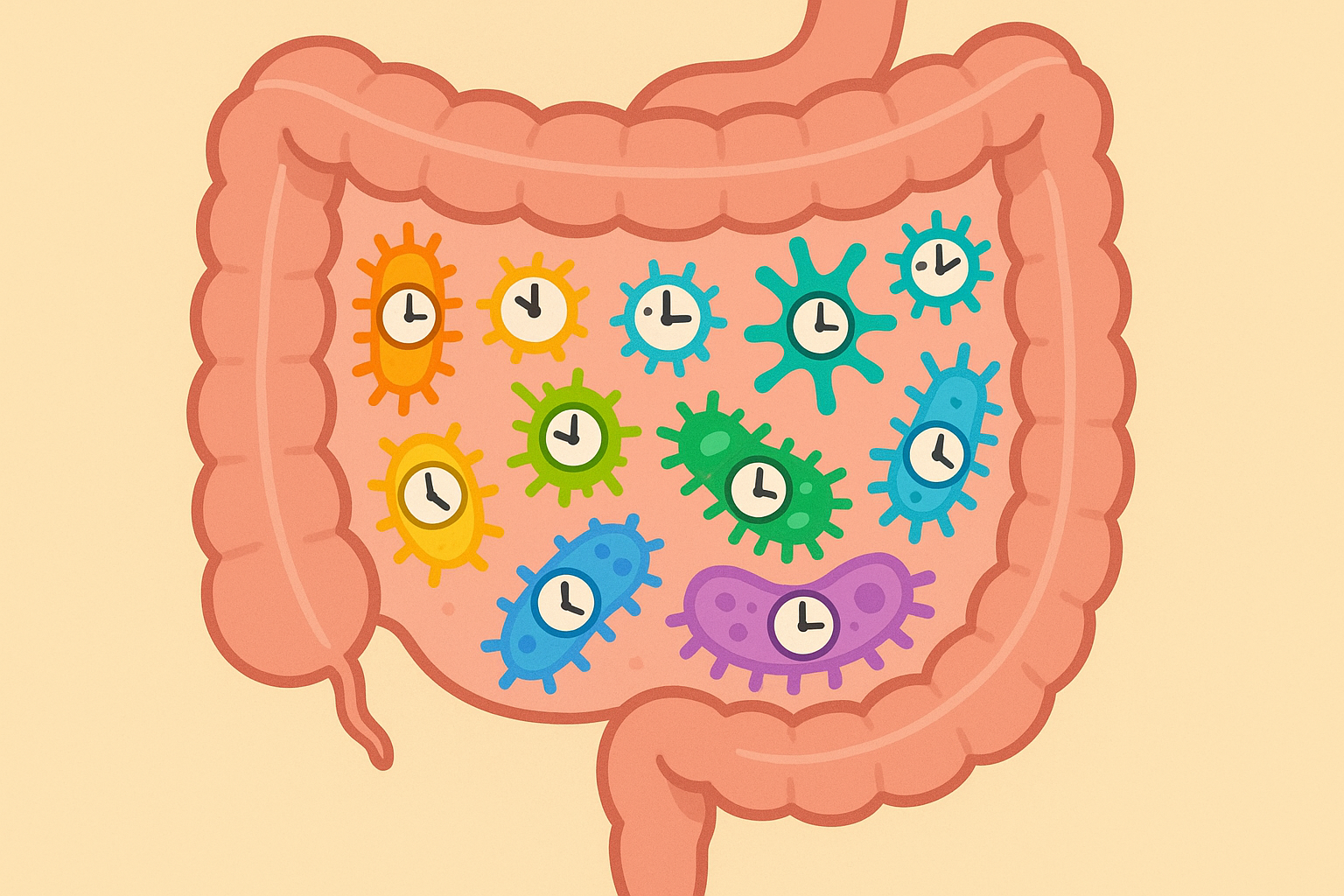
When Your Gut Bacteria Clock In and Out
Here’s what I discovered: those beneficial Lactobacillus bacteria that help you digest food and keep inflammation down? They’re morning people, just like me. They’re most active between 7-9 AM, which makes breakfast the perfect time for fermented foods.
I used to have my kefir or kombucha randomly throughout the day – sometimes with lunch, sometimes as an afternoon snack. Now I have it with breakfast, and honestly, my digestion improved within about a week. No more mid-morning stomach weirdness.
This synergizes well with understanding how drinking vinegars support gut health when timed properly.
Recent research from sports nutrition specialists emphasizes that “thirst is a late sign of dehydration” – Phoenix Children’s Hospital, highlighting how timing fluid intake throughout the day supports optimal bacterial function and nutrient absorption.
Your Digestive Enzymes Follow a Schedule
The other big revelation was about my digestive enzymes. Your pancreas doesn’t just pump out the same amount of fat-digesting enzymes all day long. They actually peak around midday, which explains why that avocado toast I used to have for dinner would sit in my stomach like a rock.
Now I save my healthy fats – nuts, avocado, olive oil – for lunch when my body is actually equipped to handle them properly. The difference is night and day. No more afternoon food comas.
Feeding Your Night Shift Workers
Here’s something that changed my recovery game: your beneficial bacteria do their best work overnight. They’re busy producing these compounds called short-chain fatty acids that reduce inflammation and help your muscles recover.
But they need the right fuel to do this job. I make sure to get about 15-20 grams of fiber with my last meal – usually from vegetables or maybe some sweet potato. Think of it like leaving snacks for the helpful house guests who work the night shift while you sleep.
The cool thing is, when you get this timing right, you wake up feeling less sore and more recovered. It took me about two weeks to notice the difference, but now it’s so obvious when I mess up the timing.
Food as Genetic Programming: Beyond Basic Nutrition
Okay, this is where things get really interesting, and I’ll admit, a bit mind-bending. I never thought about food as anything more than fuel until I learned about something called epigenetics. Basically, what you eat doesn’t just provide calories – it literally tells your genes what to do.
I know that sounds like science fiction, but stick with me here. Certain compounds in foods can flip genetic switches that control everything from how well you recover to how efficiently you produce energy. The crazy part? These changes happen fast – we’re talking 2-4 weeks, not years.
When I first heard this, I thought it was just another health fad. But then I started treating my meals like I was programming my body for better performance, and the results were impossible to ignore.
Beyond basic macronutrient timing lies epigenetic nutrition – using specific foods to literally turn genes on and off. Certain compounds can activate genes responsible for enhanced oxygen utilization, improved recovery, and increased mitochondrial density within 2-4 weeks of consistent consumption, treating food as genetic information rather than just fuel.
Your Vegetables Are Sending Text Messages to Your DNA
Those colorful compounds in vegetables – the stuff that makes blueberries blue and tomatoes red – aren’t just sitting there looking pretty. They’re actually molecular messengers that communicate directly with your DNA.
I started thinking of my plate like a control panel. Each different colored vegetable is sending specific instructions to my cells. Sounds weird, right? But when you eat the same boring foods all the time, you’re basically sending the same message over and over.
Now I make sure to get at least 5-6 different colored foods every day. My energy levels became way more consistent, and I stopped getting those random afternoon crashes that used to derail my training.
<img src="https://staging-sw 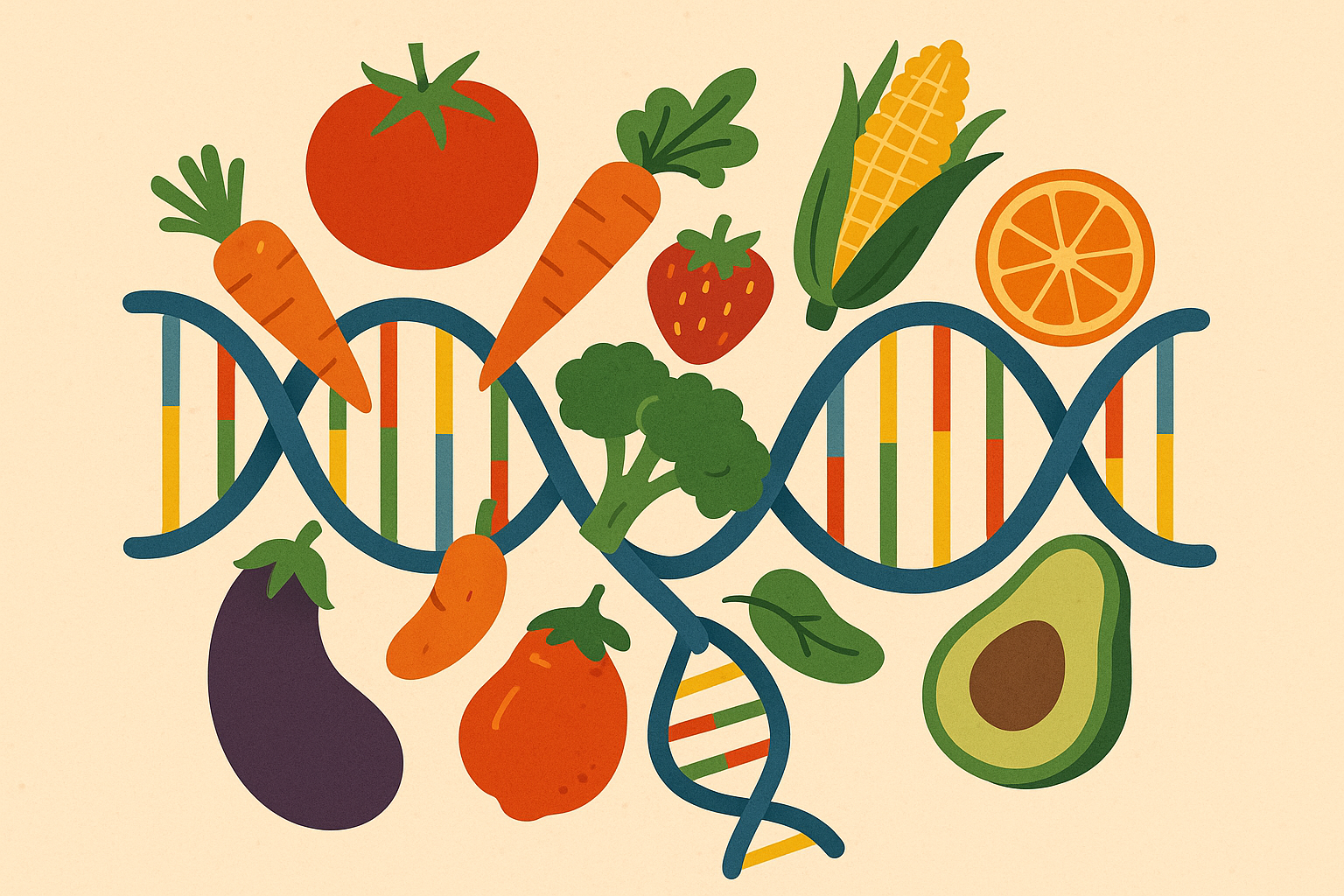
Broccoli Sprouts: Your Cellular Bodyguard Activator
Here’s something that made me feel like a health nerd, but the results were too good to ignore. Broccoli sprouts contain this compound called sulforaphane that basically turns on your body’s internal defense system.
When you eat these little green sprouts, your cells start producing their own antioxidants at 2-3 times the normal rate. It’s like upgrading your cellular security system.
I grow my own now (they’re surprisingly easy – just seeds, water, and a mason jar). I eat about half a cup three times a week. They taste pretty intense – kind of peppery and bitter – but knowing I’m literally upgrading my recovery system makes it worth choking them down.
This aligns with research on sulforaphane’s immune-supporting properties from broccoli.
Sulforaphane found in cruciferous vegetables activates pathways that enhance cellular antioxidant production. Consuming 2-3 cups of broccoli sprouts weekly can increase the body’s natural antioxidant capacity by 200-300%, providing superior protection against exercise-induced oxidative stress.
The difference in how I feel after hard training sessions is noticeable. Less soreness, better sleep, more consistent energy. It took about 3 weeks to really notice, but now it’s obvious when I skip them for too long.
The Polyphenol Power Combo
Here’s where food combining gets interesting: certain polyphenols amplify each other’s genetic effects when eaten together. Quercetin, resveratrol, and curcumin create a synergistic effect that’s way more powerful than taking them individually.
I make a point to combine these in one meal daily – usually red onions, grapes, and turmeric in a salad or stir-fry. The anti-inflammatory effects are noticeable within days.
Supporting Your Body’s Genetic Maintenance System
DNA methylation sounds complicated, but it’s basically your body’s way of maintaining genetic information. Think of it as genetic housekeeping – and athletes need more of it because we’re constantly breaking down and rebuilding tissues.
The methylation process requires specific nutrients working together, and timing matters for optimal utilization.
The B-Vitamin Trio That Powers Genetic Repair
Folate, B12, and choline are the three amigos of methylation. They work best when consumed together, especially before training when your metabolic demands spike I take these with my pre-workout meal about 2-3 hours before training. Leafy greens for folate, nutritional yeast for B12, and eggs for choline – or I’ll use targeted supplements when whole foods aren’t practical.
Beets: The Performance Enhancer That Rewrites Your Genes
Betaine from beets does double duty – it supports methylation and directly improves power output. Studies show 5-8% increases in performance with consistent use, which is huge in competitive athletics.
I consume about 2.5g daily, splitting it between my pre and post-workout meals. Sometimes it’s actual beet juice, sometimes it’s powdered beetroot. The performance boost is real and measurable.
Marcus, a powerlifter I know, started consuming 1.25g of beetroot extract before and after his training sessions. After 4 weeks, his bench press max increased by 15 pounds (about 6% improvement), and his recovery between sets noticeably improved. Blood tests showed enhanced methylation markers and reduced inflammation.
Training Your Body to Burn Any Fuel Source
Most athletes get stuck in one gear metabolically. You’re either a sugar burner or a fat burner, and when your preferred fuel runs out, you crash hard. But here’s what I learned: you can actually train your metabolism to be flexible, just like you train your muscles.
This isn’t just about going low-carb or high-carb. It’s about systematically teaching your body to efficiently switch between glucose, fat, and even ketones depending on what your training demands. Think of it like being fluent in multiple languages instead of only speaking one.
I used to be completely dependent on carbs. If I didn’t eat every 2-3 hours, I’d get shaky and irritable. Now I can go 6-8 hours without eating and still feel energized. That flexibility is a game-changer during long training sessions or competitions.
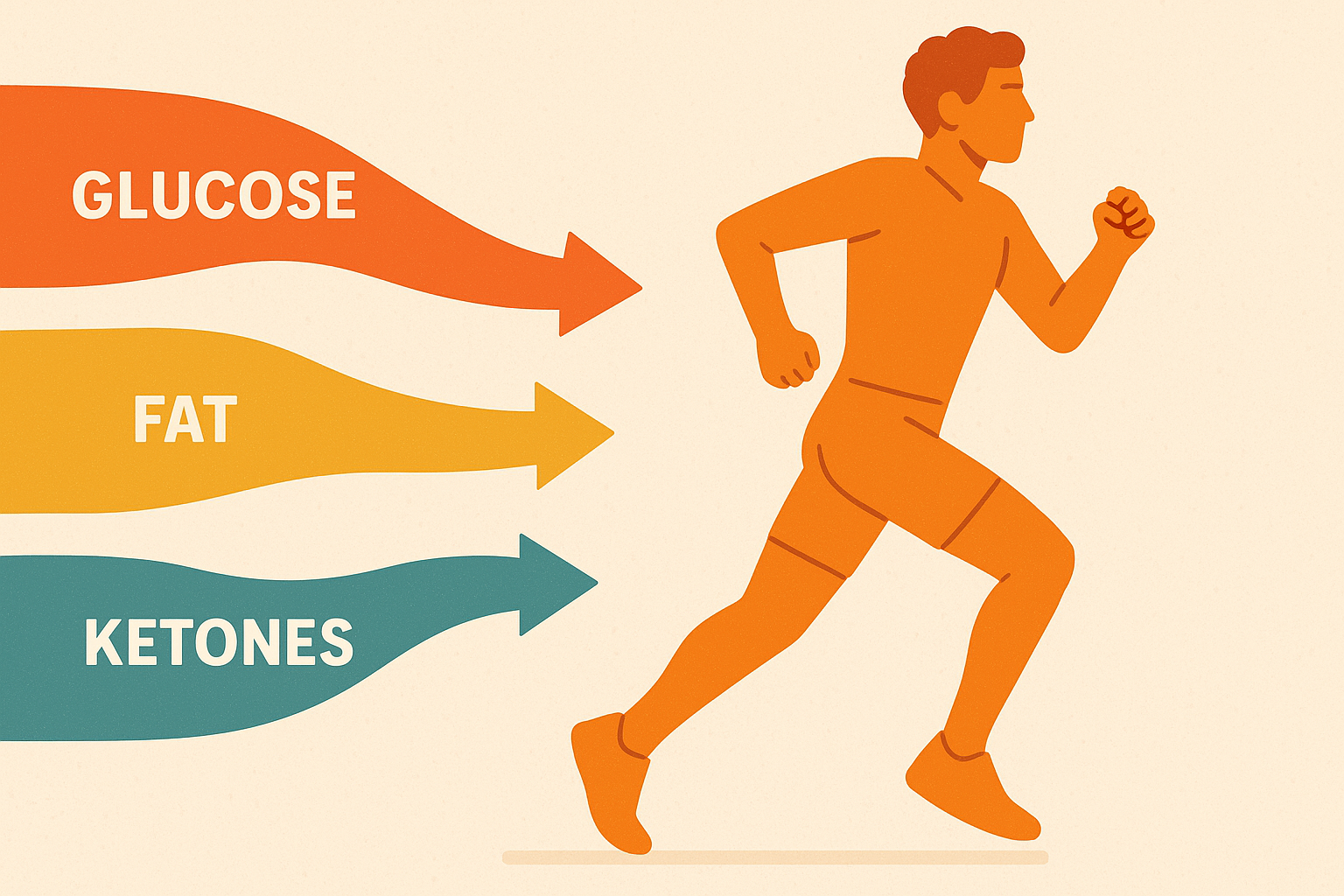
Strategic Fuel Source Training
Your metabolism is trainable, just like your muscles. Different training phases should emphasize different fuel sources to build a more complete energy system.
I now periodize my nutrition just as carefully as my training, with specific blocks focused on developing different metabolic pathways. This approach builds on the principles of finding your carb tolerance through systematic testing.
For endurance activities such as running or cycling, up to 70% of calories should come from carbohydrates, while strength activities such as weightlifting should aim for 50% of calories from carbohydrates, according to Kaiser Permanente’s sports nutrition guidelines. This demonstrates how different training demands require different fuel source emphasis.
Building Your Fat-Burning Engine
I’ll be honest – the first time I tried to become “fat-adapted,” it was brutal. I kept my carbs under 75 grams a day for about 3 weeks, only eating them around my hardest workouts. The first week sucked. I felt sluggish, my workouts suffered, and I was constantly thinking about pasta.
But by week three, something clicked. I could train fasted in the morning and feel great. My energy became incredibly stable throughout the day. It’s like I’d built this backup energy system that I never knew existed.
Building aerobic efficiency requires periods of strategic carbohydrate restriction. Implementing 2-3 week blocks where carbohydrates are limited to 50-75g daily, consumed only around high-intensity training sessions, forces the body to become more efficient at utilizing fat as fuel.
Now I do these fat-adaptation blocks 2-3 times a year, usually during easier training phases. It’s like cross-training for your metabolism.
Becoming a Carb Storage Superstar
Here’s the cool part about training your fat-burning system: when you go back to eating carbs, your muscles become like bigger fuel tanks. After a fat-adaptation phase, I can store 20-40% more glycogen than before.
The protocol is pretty intense though. Three days of depletion training with minimal carbs (this part sucks), followed by 2-3 days of massive carb loading – we’re talking 8-12 grams per kilogram of body weight. For me, that’s like 600-900 grams of carbs per day.
The performance boost afterward is incredible. It’s like having a turbo button that actually works.
Teaching Your Brain to Use Ketones
Your brain can run on ketones, but it needs practice. I do 3-day very low carb periods (under 20g) monthly, maintaining moderate training intensity. The mental clarity that develops is remarkable, and it provides insurance for long training sessions or competitions.
The first time I tried this, I felt pretty foggy for the first day or two. But by day three, my focus was laser-sharp. It’s like giving your brain a completely different operating system to work with.
Directing Nutrients Where You Want Them
Not all calories go to the same place. You can actually influence whether nutrients get stored as muscle, liver glycogen, or fat through strategic timing and combinations.
This is advanced stuff, but the results speak for themselves when you get it right.
Cycling Your Carb Sensitivity
I match my carb intake to my training intensity. High-intensity days get 6-8g per kg body weight, while easy days stay under 2-3g per kg.
This keeps my insulin sensitivity sharp while ensuring I have fuel when I need it most. The body composition changes are noticeable within weeks.
Targeting Specific Muscles
You can actually direct nutrients to specific muscles by consuming targeted amino acids before training those areas. The 2:1:1 ratio of leucine, valine, and isoleucine works best.
I consume this combo 30 minutes before training my weakest muscle groups. It sounds questionable, but the targeted growth is real.
| Training Phase | Primary Fuel Source | Carb Intake (g/kg) | Fat Intake (%) | Training Focus |
|---|---|---|---|---|
| Fat Adaptation | Fat oxidation | 1-2g | 60-70% | Aerobic base building |
| Glycogen Loading | Glucose | 8-12g | 15-20% | Competition prep |
| Ketone Training | Ketones | <0.5g | 75-80% | Mental adaptation |
| Maintenance | Mixed | 4-6g | 25-35% | General training |
Feeding Your Brain for Mental Performance
Your brain uses about 20% of your daily calories, but most athletic nutrition plans completely ignore it. I used to think mental fatigue was just part of training hard until I learned you can actually feed your brain for better performance.
Mental clarity, decision-making speed, and stress tolerance can all be enhanced through strategic brain nutrition. And honestly, the performance gains are just as real as the physical improvements.
Think about it – how many times has your body felt fine during competition, but your brain just couldn’t keep up? Poor decisions, slow reactions, inability to push through discomfort – that’s often nutritional, not just mental toughness.
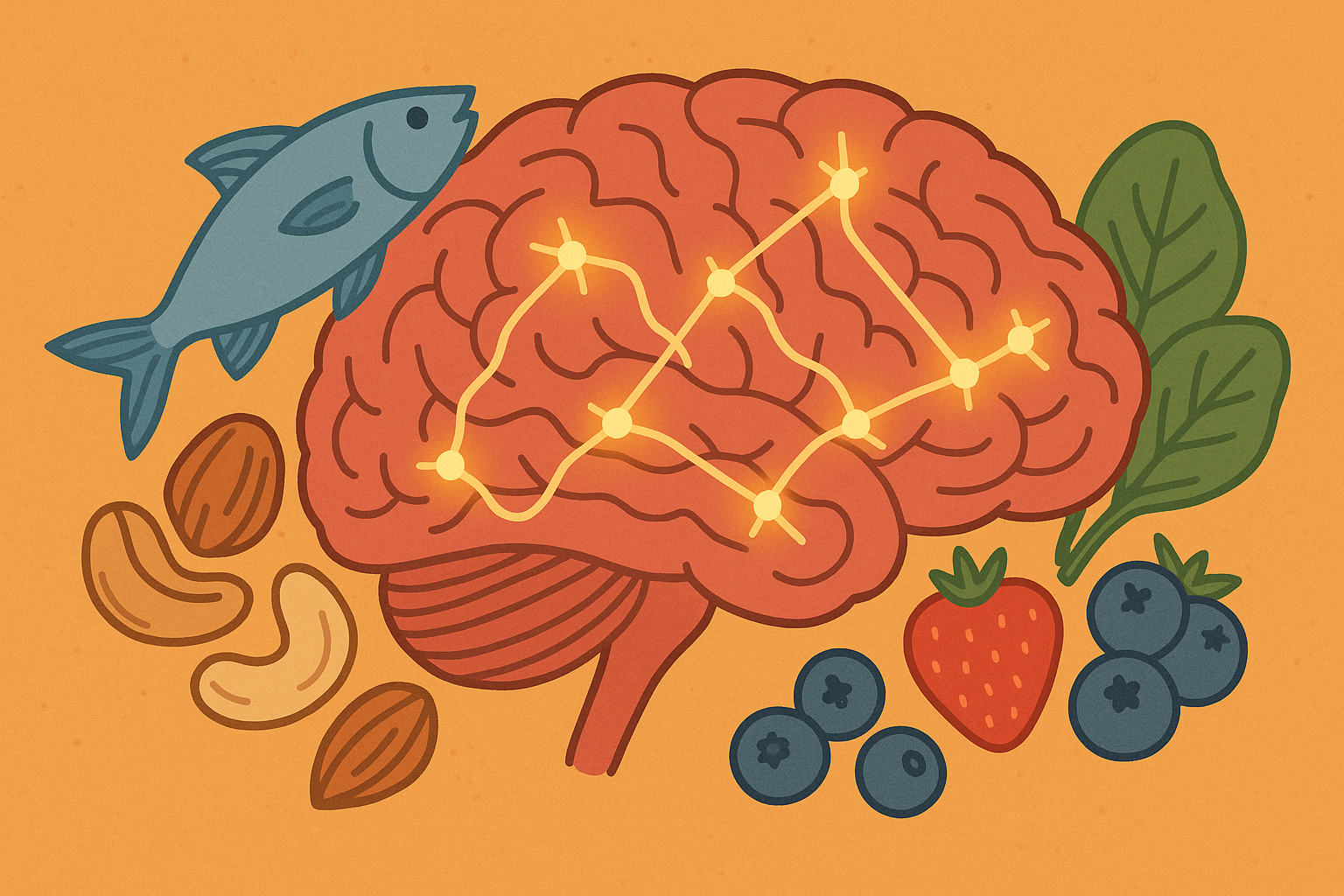
Timing Your Brain’s Chemical Messengers
Your brain runs on chemical messengers called neurotransmitters, and they need specific raw materials to function properly. The timing of when you consume these raw materials can dramatically impact your mental game.
I learned to treat these nutrients like performance supplements, timing them strategically for maximum cognitive benefit.
Boosting Your Motivation Chemistry
For motivation and focus, I take L-tyrosine about 90 minutes before mentally challenging sessions – usually 1000-1500mg. The difference in drive and mental sharpness is noticeable within an hour. It’s like having better mental endurance.
Combined with B6 and iron, the conversion to dopamine is optimized. This is especially helpful during those grinding training sessions where motivation starts to wane.
Sports nutrition experts now recognize that “nutrition is the foundation for health, growth, and performance” – Atrium Health, emphasizing how proper brain nutrition directly impacts athletic success beyond just physical fuel.
Managing Your Mood and Pain Tolerance
For managing mood and pain tolerance, I use tryptophan (the stuff in turkey) with carbs but no other proteins about 2-3 hours before evening sessions. This helps with serotonin production, which affects how much discomfort you can tolerate during training.
Turkey with sweet potato works, or I’ll use isolated tryptophan with fruit. The key is avoiding other amino acids that compete for brain access.
Calming Your Nervous System
For calming my nervous system before bed, I take magnesium and L-theanine about 90 minutes before sleep. I take 400mg magnesium glycinate with 200mg theanine. The sleep improvement was immediate, and better sleep means better next-day brain function.
This combination acts like your brain’s brake pedal, helping you wind down after intense training sessions.
Jessica, a tennis player I know, struggled with decision-making during long matches. She started taking 1200mg L-tyrosine 90 minutes before matches, combined with B6. Within two weeks, her unforced errors decreased by 30%, and she reported feeling more mentally sharp during crucial points.
The Energy Field of Food (Yes, Really)
Okay, I know this sounds totally out there, but hear me out. Fresh foods actually carry electromagnetic energy that processed foods don’t have. Your cells operate on electrical charges, and the energy signature of your food affects how your cells function.
I was completely skeptical about this until I started tracking my recovery metrics while eating only fresh, local foods versus my usual mix of fresh and processed stuff. The differences were measurable on my heart rate variability monitor and sleep tracker.
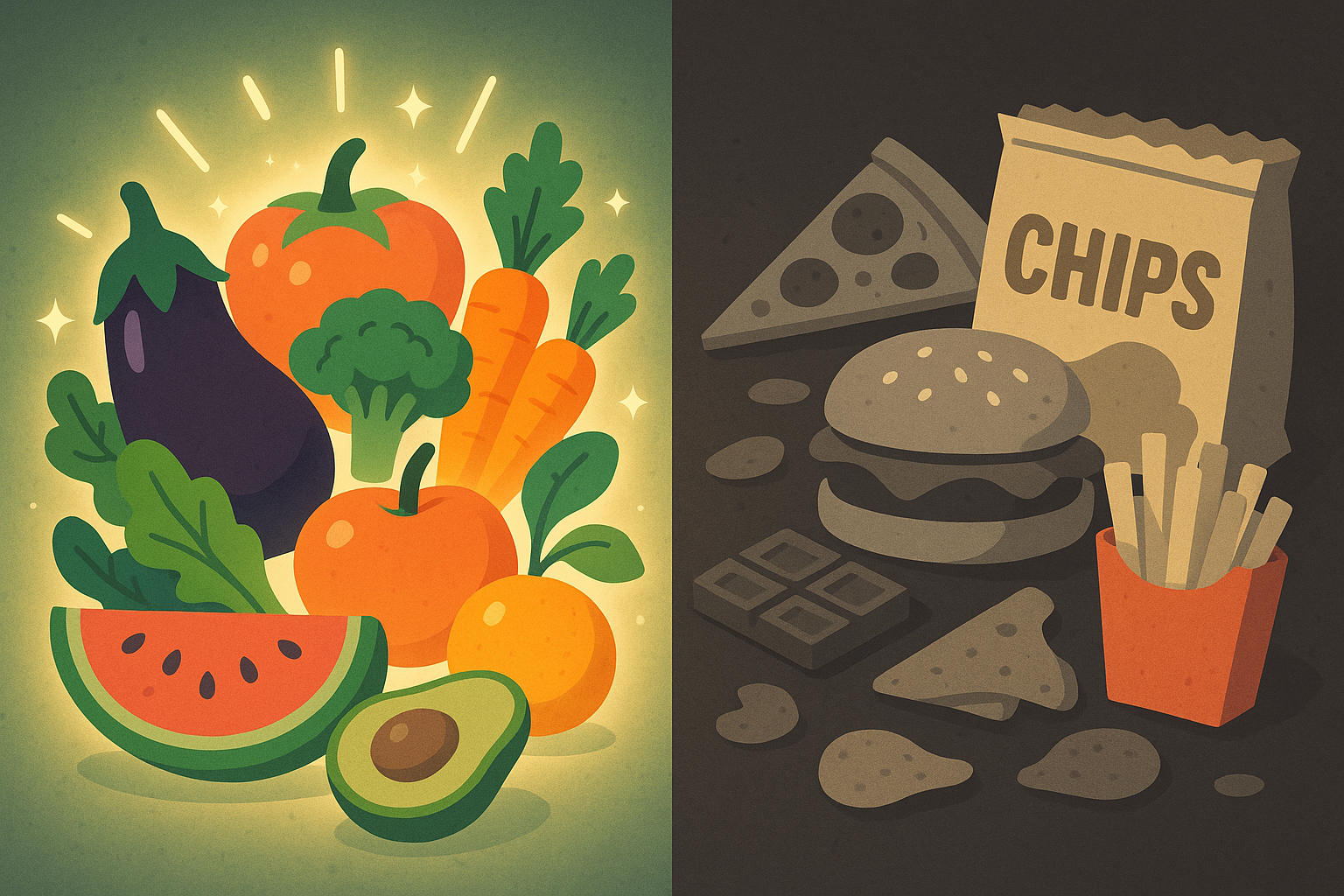
The Electrical Properties of Fresh Food
Fresh, organic produce literally emits light energy – it’s called biophotons, and you can measure it with specialized equipment. Processed foods lose this energy signature completely.
I started prioritizing foods harvested within 24-48 hours when possible. This meant more farmers market shopping and growing my own sprouts. The difference in how I feel is subtle but consistent – more energy, better recovery, improved mood.
Measuring Food’s Light Energy
I know it sounds mystical, but it’s actually measurable science. Fresh organic produce emits 10-1000 times more light energy than processed foods. This isn’t new-age nonsense – you can literally measure it with specialized equipment.
I’ve started shopping at farmers markets and growing my own sprouts to maximize this light energy intake. The energy difference is real, even if the mechanism isn’t fully understood.
Your Cells Are Basically Tiny Batteries
Here’s what made this click for me: your cells maintain an electrical charge of about -70 to -90 millivolts. They’re literally tiny batteries. Fresh foods support this electrical charge , while processed foods can drain it.
I started noticing that meals of fresh, raw foods leave me feeling energized, while processed meals create this subtle energy drain. Once I understood that my cells run on electricity, the whole “energy field of food” thing made perfect sense.
The Superior Hydration of Living Foods
The water in fresh foods isn’t the same as what comes out of your tap. It exists in this structured, gel-like state that your cells can absorb way more efficiently.
I now get 2-3 cups of high-water-content foods daily – cucumber, watermelon, coconut water – especially around workouts. The hydration is noticeably more effective than just drinking water. My urine stays lighter throughout the day, and I feel more consistently hydrated.
Athletes should consume 80 to 96 ounces of water per day, significantly more than the general population’s 48 to 64 ounces, according to Kaiser Permanente sports medicine guidelines. Structured water from fresh foods can help meet these elevated hydration needs more effectively.
Hydration That Actually Works
Eating water-rich foods like cucumber, watermelon, and coconut provides superior hydration compared to just drinking water. The difference in cellular hydration is noticeable.
This approach complements hydrating summer foods for optimal performance. It’s like the difference between drinking water and actually getting hydrated at the cellular level.
Natural Mineral Delivery Systems
The minerals in fresh foods come packaged in structured water with cofactors your body recognizes. This natural matrix absorbs 40-60% better than isolated supplements.
I’ve reduced my supplement intake significantly since focusing on mineral-rich whole foods. Blood tests show better mineral status despite taking fewer pills.
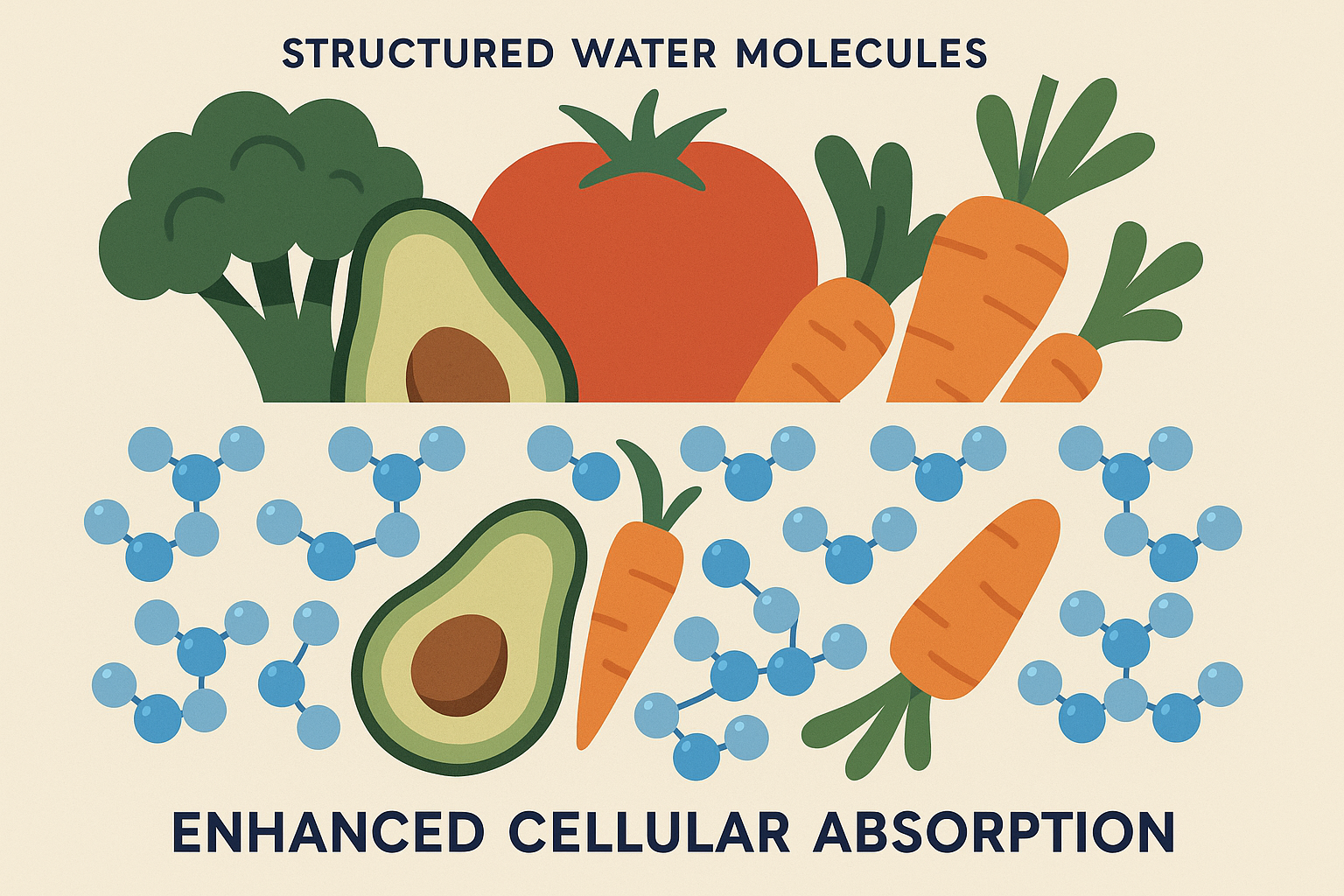
Eating With the Seasons Like Our Ancestors Did
Your metabolism isn’t supposed to be the same year-round. Seasonal changes in daylight, temperature, and available foods trigger metabolic shifts that most athletes completely ignore.
I started paying attention to these patterns after noticing I naturally craved different foods in different seasons. Turns out, there’s solid science behind these instincts, and working with them instead of against them makes everything easier.
Your Body’s Annual Biological Clock
Your body operates on annual rhythms just as real as your daily ones. Thyroid function, immune activity, and metabolic rate all shift predictably throughout the year.
Instead of fighting these changes, I now work with them. My nutrition periodization follows seasonal patterns, not just training cycles.
Spring: Your Body’s Natural Detox Season
Spring naturally activates your liver’s detox pathways. This isn’t new-age nonsense – it’s measurable biochemistry tied to increasing daylight hours.
I now emphasize bitter greens, cruciferous vegetables, and longer fasting windows during spring. My energy levels and mental clarity improve dramatically during this seasonal transition. It’s like my body knows it’s time for spring cleaning.
Spring Nutrition Checklist:
- Increase bitter greens (arugula, dandelion, kale)
- Add sulfur-rich vegetables (broccoli, cauliflower)
- Extend overnight fasting to 14-16 hours
- Reduce heavy, warming foods
- Increase fresh herbs and sprouts
Summer: Peak Performance Season
Summer’s longer days and heat naturally ramp up your metabolism and improve your carb tolerance. This is when your body can handle the highest training loads and carbohydrate intake.
I increase my carbs to 6-8 grams per kilogram during summer training blocks and focus heavily on hydration. The performance gains during this season are consistently the highest. It’s like your body is designed to peak when the days are longest.
Fall: Preparation and Transition
As daylight decreases in fall, your body naturally shifts toward storing more fat and your insulin sensitivity decreases. Fighting this transition leads to energy crashes and poor recovery.
I gradually increase healthy fats to 35-40% of calories during fall while cutting back on refined carbs. This supports the natural metabolic transition instead of working against it.
Winter: Recovery and Restoration Focus
Winter is nature’s recovery season. Shorter days and cold temperatures naturally promote deeper sleep and enhanced cellular repair processes.
My winter nutrition emphasizes warming foods, higher protein intake, and immune-supporting nutrients. I also increase vitamin D supplementation and focus on mood-stabilizing nutrients during the darker months.

Adapting to Your Geographic Location
Your optimal nutrition depends on where you live. Altitude, climate, and local food ecosystems all influence your nutritional needs.
I’ve noticed my best performance periods coincide with eating locally grown, seasonal foods. There’s something to be said for consuming what grows naturally in your environment.
High Altitude Metabolic Changes
Training above 5,000 feet changes everything. Your metabolic rate increases, iron needs spike, and appetite often decreases – a problematic combination for athletes.
I’ve learned to increase iron-rich foods and eat smaller, more frequent meals when training at altitude. The adjustment period is shorter when you support these metabolic changes nutritionally.
Climate-Specific Hydration Strategies
Humid versus dry climates require completely different hydration strategies. I learned this the hard way during a training camp in Florida after living in Colorado.
Now I test my sweat sodium losses in different climates and adjust accordingly. Humid environments typically require 200-400mg more sodium per hour – a significant difference that impacts performance if ignored.
Altitude Training Nutrition Protocol:
- Increase iron intake by 25-30%
- Reduce meal sizes by 20%
- Increase meal frequency to 6-7 times daily
- Boost B-vitamin intake for energy metabolism
- Monitor hydration more closely
Working with these seasonal patterns instead of fighting them has made my training periodization way more effective and sustainable.
Final Thoughts
Look, I get it. This stuff can seem overwhelming at first. When I started learning about circadian nutrition and seasonal eating, I thought I was going down some weird rabbit hole.
But here’s the thing – I’ve been implementing these strategies for over two years now, and the difference is remarkable. Better recovery, more consistent energy, improved focus, and performance gains that seemed impossible with traditional approaches.
The hardest part isn’t the science – it’s breaking free from the idea that you can just eat whatever, whenever, as long as you hit your macro targets. But once you experience the difference that proper timing makes, there’s no going back to random meal schedules.
Understanding proper digestion techniques becomes crucial when implementing these advanced timing protocols, as optimal nutrient absorption depends on healthy gut function.
Start small. Pick one thing – maybe just eating your biggest carb meal in the morning, or having fermented foods with breakfast. Stick with it for two weeks and see how you feel. Then add another piece.
Your body is way more sophisticated than a simple machine that needs fuel. When you start treating it like the complex biological system it actually is, everything changes.
For athletes serious about optimizing every aspect of their performance, Organic Authority’s marine collagen provides the bioavailable protein support that complements these advanced timing strategies perfectly. Their commitment to clean, scientifically-backed supplements aligns with the precision approach that circadian nutrition demands. Ready to transform your athletic meal plan? Start tracking your natural rhythms and begin timing your nutrition for peak performance.

